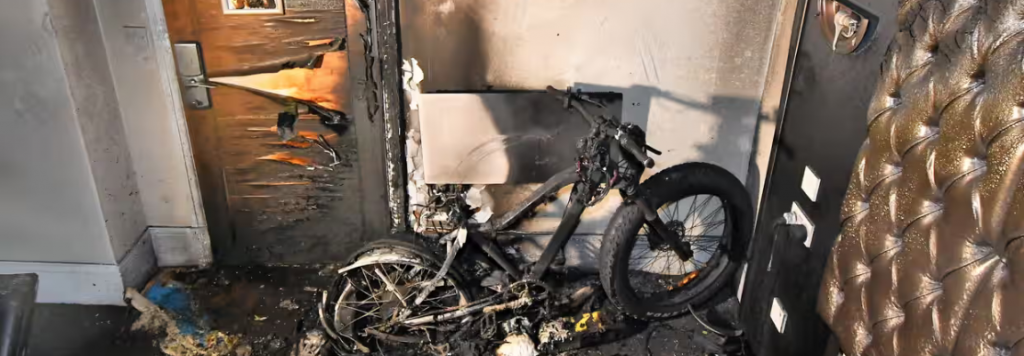Home » Residential » Tenant Guides » E-bikes and Scooters
E-bikes and Scooters: Safety and Best Practices

As e-bikes and electric scooters become more popular, it’s important to understand the potential risks associated with their use and how to keep yourself and your property safe.
Understanding the Risks
E-bikes and electric scooters are convenient, eco-friendly modes of transport, but they do come with certain risks, especially related to their batteries. Lithium-ion batteries, which power most e-bikes and scooters, can pose a fire risk if not used, charged, or stored properly. These fires can happen suddenly and spread quickly, putting lives and property at risk.
Key Safety Tips
1. Charging Safely
- Use the Manufacturer’s Charger: Always use the charger provided by the manufacturer. Third-party chargers might not be compatible and can lead to overcharging, which increases the risk of fire.
- Supervise Charging: Never leave your e-bike or scooter charging overnight or while you are out. Always monitor the device while it is charging to quickly address any issues.
- Ventilated Area: Charge your device in a well-ventilated area away from flammable materials such as curtains, furniture, or papers.
2. Storage Tips
- Cool and Dry Location: Store your e-bike or scooter in a cool, dry place, away from direct sunlight or heat sources. Heat can increase the risk of the battery overheating.
- Avoid Damp Areas: Keep your device away from water or damp areas, as moisture can cause electrical shorts that may lead to fires.
- Keep Hallways and Corridors Clear: As per your tenancy agreement, e-bikes and scooters must not be stored in hallways, corridors, or any areas that may obstruct escape routes. This is crucial for ensuring that exits remain accessible in case of an emergency.
3. Inspect Your Equipment
- Check for Damage: Regularly inspect your e-bike or scooter for any signs of damage, especially to the battery and charging port. If you notice any unusual signs such as bulging, cracks, or a burning smell, stop using the device immediately and consult a professional.
- Battery Condition: Be mindful of the battery’s condition. If it becomes hot to the touch or behaves erratically (e.g., losing charge quickly or taking a long time to charge), it could be a sign of a problem.
4. Safe Usage Practices
- Don’t Overload: Follow the manufacturer’s guidelines on weight limits. Overloading your e-bike or scooter can strain the battery and other components, leading to potential hazards.
- Avoid Rough Handling: Dropping or rough handling of your e-bike or scooter can damage the battery, increasing the risk of fire.
5. General Guidelines
- No Charging in Communal Areas: To ensure everyone’s safety, do not charge e-bikes or scooters in communal areas such as hallways or lounges. These spaces need to remain clear in case of an emergency.
- Limit the Number of Devices: If you have multiple e-bikes or scooters, charge and store them one at a time to reduce the overall risk.
Reference
https://www.theguardian.com/news/2023/may/02/e-bike-e-scooter-battery-fires-uk-data
